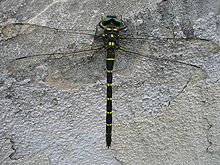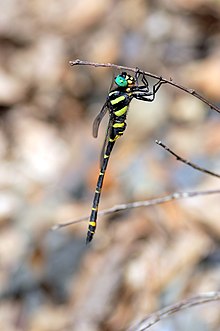Anotogaster sieboldii: Difference between revisions
Refine category |
mNo edit summary |
||
| (10 intermediate revisions by 10 users not shown) | |||
| Line 1: | Line 1: | ||
{{Short description|Species of dragonfly}} |
|||
{{italic title}} |
|||
{{Speciesbox |
{{Speciesbox |
||
| image = Anotogaster sieboldii on wall.jpg |
| image = Anotogaster sieboldii on wall.jpg |
||
| image_width = 200px |
|||
| image_caption = Adult |
| image_caption = Adult |
||
| taxon = Anotogaster sieboldii |
| taxon = Anotogaster sieboldii |
||
| authority = [[Edmond de Sélys Longchamps|Sélys]], 1854 |
| authority = [[Edmond de Sélys Longchamps|Sélys]], 1854 |
||
}} |
}} |
||
'''''Anotogaster sieboldii''''', as known as '''golden-ringed dragonfly''', '''jumbo dragonfly''', '''Siebold's dragonfly''' or {{Nihongo|'''oniyanma'''|オニヤンマ、鬼蜻蜓、馬大頭}} in [[Japanese language|Japanese]], '''無霸勾蜓''' in [[Chinese language]] and '''장수잠자리'''("jang-su-jamjari", means 'General Dragonfly') in [[Korean language]] is the largest species of [[dragonfly]] native to [[Eastern Asia]], especially [[Japan]], [[China]], [[Korean Peninsula]].<ref>''한국의 잠자리(The Dragonflies and Damselflies of Korea)'', 자연과생태(http://www.econature.co.kr/), 2012.</ref> It can grow between 95 and 100 mm in length.<ref>''ふしぎがわかる しぜん図鑑 こんちゅう'', page 35. Froebel-Kan CO., LTD., 1999</ref> |
'''''Anotogaster sieboldii''''', as known as '''golden-ringed dragonfly''', '''jumbo dragonfly''', '''Siebold's dragonfly''' or {{Nihongo|'''oniyanma'''|オニヤンマ、鬼蜻蜓、馬大頭}} in [[Japanese language|Japanese]], '''無霸勾蜓''' in [[Chinese language|Chinese]] and '''장수잠자리'''("jang-su-jamjari", means 'General Dragonfly') in [[Korean language|Korean]] is the largest species of [[dragonfly]] native to [[Eastern Asia]], especially [[Japan]], [[Taiwan]], [[China]], [[Korean Peninsula]].<ref>''한국의 잠자리(The Dragonflies and Damselflies of Korea)'', 자연과생태(http://www.econature.co.kr/), 2012.</ref> It can grow between 95 and 100 mm in length.<ref>''ふしぎがわかる しぜん図鑑 こんちゅう'', page 35. Froebel-Kan CO., LTD., 1999</ref> |
||
==Life cycle== |
==Life cycle== |
||
[[image:Anotogaster sieboldii.jpg|thumb|left|alt= Anotogaster sieboldii on a twig|An adult on a twig. photographed in Nasu Highlands of [[Tochigi Prefecture|Tochigi]], [[Japan]]]] Eggs hatch within a month of being laid. [[Nymph]] |
[[image:Anotogaster sieboldii.jpg|thumb|left|alt= Anotogaster sieboldii on a twig|An adult on a twig. photographed in Nasu Highlands of [[Tochigi Prefecture|Tochigi]], [[Japan]]]] Eggs hatch within a month of being laid. [[Nymph (biology)|Nymphs]] can live for three to five years, [[Ecdysis|moulting]] as many as ten times and growing as large as five centimeters in length. Like adult dragonfly, nymphs are obviously [[predatory]] insects. Once nymphs' size bigger and bigger, they hunt [[tadpole]]s, [[aquatic insects]] and small fish. The adult dragonfly [[Mating|mate]] and lay eggs within one to two months of [[metamorphosis]]. After mating, females head toward small creeks or ponds, not fast-moving rivers or lakes, to lay eggs. They will sometimes fly perpendicularly to the water, laying their eggs in mud or sand under the surface. |
||
[[Image:Anotogaster sieboldii 01.jpg|thumb|Anotogaster sieboldii]] |
|||
[[Image:Anotogaster sieboldii 03.jpg|thumb|Anotogaster sieboldii]] |
|||
[[Image:Anotogaster sieboldii 04.jpg|thumb|Anotogaster sieboldii]] |
|||
{{Clear}} |
{{Clear}} |
||
| Line 17: | Line 20: | ||
==References== |
==References== |
||
*{{cite book |script-title=ja:ふしぎがわかる しぜん図鑑 こんちゅう |
*{{cite book |script-title=ja:ふしぎがわかる しぜん図鑑 こんちゅう |year=1999 |publisher=Froebel-Kan CO., LTD. |location=Tokyo, Japan |isbn=4-577-00033-4 |page=35 |url=http://www.froebel-kan.co.jp|language=ja}} |
||
{{Taxonbar|from=Q1303921}} |
|||
{{DEFAULTSORT:Anotogaster Sieboldii}} |
|||
[[Category:Cordulegastridae]] |
[[Category:Cordulegastridae]] |
||
[[Category:Insects described in 1854]] |
[[Category:Insects described in 1854]] |
||
Latest revision as of 07:50, 2 September 2021
| Anotogaster sieboldii | |
|---|---|

| |
| Adult | |
| Scientific classification | |
| Domain: | Eukaryota |
| Kingdom: | Animalia |
| Phylum: | Arthropoda |
| Class: | Insecta |
| Order: | Odonata |
| Infraorder: | Anisoptera |
| Family: | Cordulegastridae |
| Genus: | Anotogaster |
| Species: | A. sieboldii
|
| Binomial name | |
| Anotogaster sieboldii Sélys, 1854
| |
Anotogaster sieboldii, as known as golden-ringed dragonfly, jumbo dragonfly, Siebold's dragonfly or oniyanma (オニヤンマ、鬼蜻蜓、馬大頭) in Japanese, 無霸勾蜓 in Chinese and 장수잠자리("jang-su-jamjari", means 'General Dragonfly') in Korean is the largest species of dragonfly native to Eastern Asia, especially Japan, Taiwan, China, Korean Peninsula.[1] It can grow between 95 and 100 mm in length.[2]
Life cycle[edit]

Eggs hatch within a month of being laid. Nymphs can live for three to five years, moulting as many as ten times and growing as large as five centimeters in length. Like adult dragonfly, nymphs are obviously predatory insects. Once nymphs' size bigger and bigger, they hunt tadpoles, aquatic insects and small fish. The adult dragonfly mate and lay eggs within one to two months of metamorphosis. After mating, females head toward small creeks or ponds, not fast-moving rivers or lakes, to lay eggs. They will sometimes fly perpendicularly to the water, laying their eggs in mud or sand under the surface.



Notes[edit]
- ^ 한국의 잠자리(The Dragonflies and Damselflies of Korea), 자연과생태(http://www.econature.co.kr/), 2012.
- ^ ふしぎがわかる しぜん図鑑 こんちゅう, page 35. Froebel-Kan CO., LTD., 1999
References[edit]
- ふしぎがわかる しぜん図鑑 こんちゅう (in Japanese). Tokyo, Japan: Froebel-Kan CO., LTD. 1999. p. 35. ISBN 4-577-00033-4.
